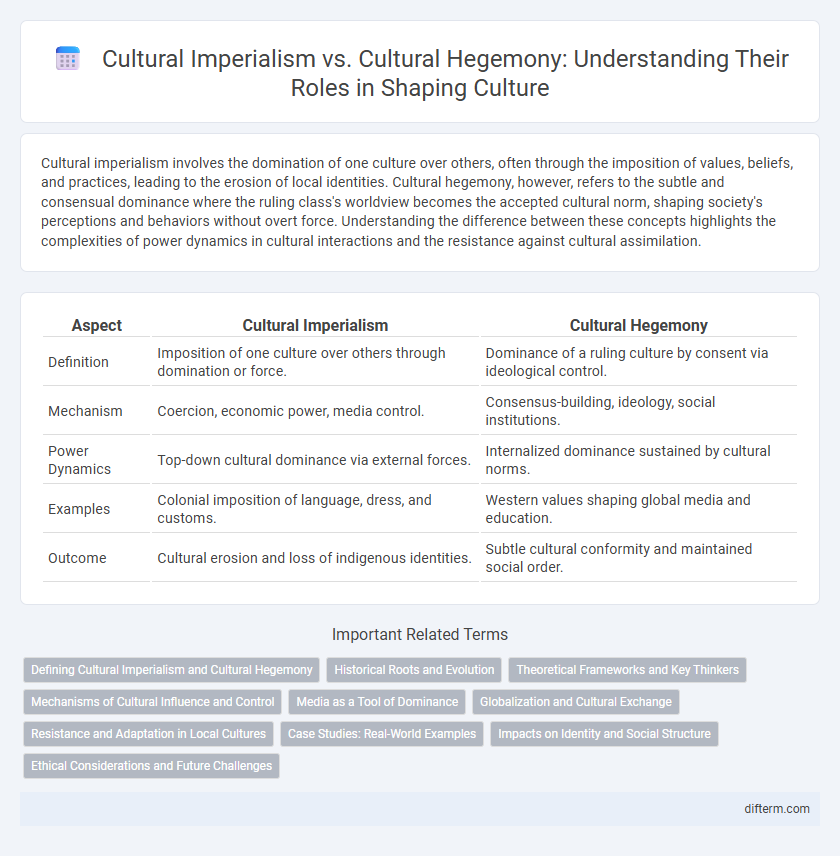Cultural imperialism involves the domination of one culture over others, often through the imposition of values, beliefs, and practices, leading to the erosion of local identities. Cultural hegemony, however, refers to the subtle and consensual dominance where the ruling class's worldview becomes the accepted cultural norm, shaping society's perceptions and behaviors without overt force. Understanding the difference between these concepts highlights the complexities of power dynamics in cultural interactions and the resistance against cultural assimilation.
Table of Comparison
| Aspect | Cultural Imperialism | Cultural Hegemony |
|---|---|---|
| Definition | Imposition of one culture over others through domination or force. | Dominance of a ruling culture by consent via ideological control. |
| Mechanism | Coercion, economic power, media control. | Consensus-building, ideology, social institutions. |
| Power Dynamics | Top-down cultural dominance via external forces. | Internalized dominance sustained by cultural norms. |
| Examples | Colonial imposition of language, dress, and customs. | Western values shaping global media and education. |
| Outcome | Cultural erosion and loss of indigenous identities. | Subtle cultural conformity and maintained social order. |
Defining Cultural Imperialism and Cultural Hegemony
Cultural imperialism refers to the dominance of one culture over others through the imposition of its values, practices, and media, often driven by economic and political power. Cultural hegemony, a concept developed by Antonio Gramsci, describes the subtle, pervasive influence whereby a ruling class's worldview becomes the accepted cultural norm, shaping societal beliefs and behaviors without overt coercion. Both concepts illuminate different mechanisms of cultural dominance, with imperialism highlighting external imposition and hegemony emphasizing internalized consent.
Historical Roots and Evolution
Cultural imperialism traces its roots to colonial expansion during the 15th to 19th centuries when European powers imposed their language, religion, and customs on indigenous populations worldwide. Cultural hegemony, a concept developed by Antonio Gramsci in the early 20th century, explains how dominant groups maintain power by shaping cultural norms and ideologies without overt force. Over time, both concepts evolved to analyze the subtle mechanisms through which Western media, education, and consumer culture influence global identities and social structures.
Theoretical Frameworks and Key Thinkers
Cultural imperialism is analyzed through the theoretical framework of dominance by powerful nations imposing their culture, with key thinkers like Herbert Schiller highlighting media and communication control as tools of cultural dominance. Cultural hegemony, conceptualized by Antonio Gramsci, explains how ruling classes maintain power by shaping cultural norms and ideologies to secure consent rather than coercion. Both theories emphasize the interplay between culture and power but differ in mechanisms: one centers on external imposition, the other on internal consensus-building.
Mechanisms of Cultural Influence and Control
Mechanisms of cultural imperialism involve the direct imposition of dominant cultural values and practices through economic and political power, often marginalizing local traditions. Cultural hegemony operates more subtly by shaping societal norms and ideologies through media, education, and institutions, making the dominant culture appear natural and desirable. Both processes reinforce power dynamics by controlling cultural narratives and limiting alternative cultural expressions.
Media as a Tool of Dominance
Media functions as a critical tool of dominance in both cultural imperialism and cultural hegemony by shaping narratives and controlling the dissemination of information. Cultural imperialism leverages global media networks to impose dominant cultural values, often marginalizing local traditions and identities. In contrast, cultural hegemony maintains power by subtly embedding ruling class ideologies within media content, normalizing these perspectives as the cultural norm.
Globalization and Cultural Exchange
Cultural imperialism refers to the dominance of one culture over others through media, language, and consumer products, often driven by powerful nations in the process of globalization. Cultural hegemony involves the subtle shaping of values and norms by a dominant culture, influencing global perceptions and social practices without overt coercion. Globalization facilitates extensive cultural exchange, where hybridization emerges as local traditions adapt and blend with global influences, challenging the binary of dominance and resistance.
Resistance and Adaptation in Local Cultures
Local cultures exhibit resilience through resistance and adaptation in the face of cultural imperialism and hegemony, preserving indigenous traditions while selectively integrating external influences. Resistance manifests in the revitalization of native languages, rituals, and art forms that challenge dominant cultural narratives imposed by imperial forces. Adaptation involves the reconfiguration of global cultural elements to fit local contexts, fostering hybrid identities that both confront and negotiate hegemonic power structures.
Case Studies: Real-World Examples
Cultural imperialism manifests in the widespread adoption of Western consumer products and media in countries like India, often overshadowing local traditions and languages. In contrast, cultural hegemony is evident in Italy's dominant media narratives that shape public opinions, reinforcing the ruling class's values without overt coercion. Case studies from post-colonial Africa reveal how cultural imperialism disrupts indigenous cultural frameworks, while cultural hegemony subtly maintains existing power structures through education and popular culture.
Impacts on Identity and Social Structure
Cultural imperialism often imposes dominant cultural values that disrupt indigenous identities, leading to the erosion of local traditions and social cohesion. In contrast, cultural hegemony subtly shapes identity through the pervasive acceptance of dominant norms, reinforcing existing power structures within society. Both phenomena impact social structures by influencing individuals' sense of belonging and perpetuating inequalities rooted in cultural dominance.
Ethical Considerations and Future Challenges
Cultural imperialism raises ethical concerns about the dominance of one culture imposing values and practices on others, often leading to the erosion of local traditions and identities. Cultural hegemony, while subtler, involves the dominant culture shaping societal norms and beliefs through ideological means, creating power imbalances that affect autonomy and diversity. Future challenges include addressing cultural homogenization and ensuring the protection of marginalized cultures while promoting intercultural dialogue and ethical cultural exchange.
cultural imperialism vs cultural hegemony Infographic

 difterm.com
difterm.com